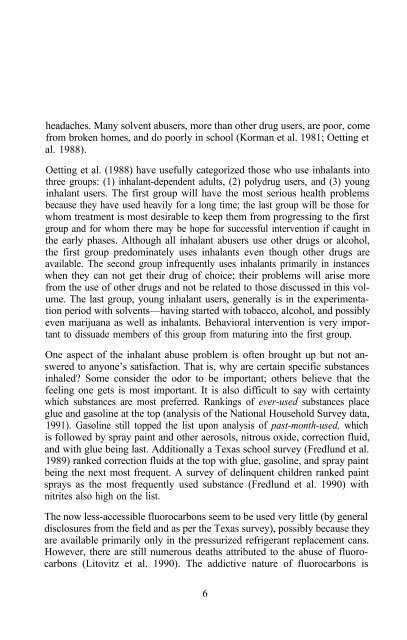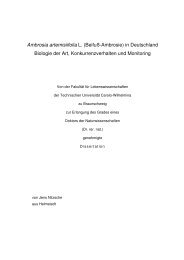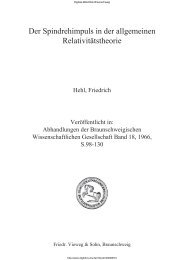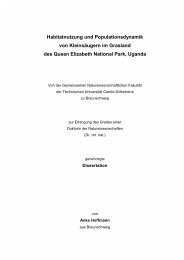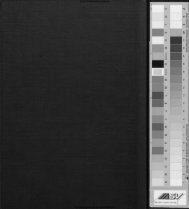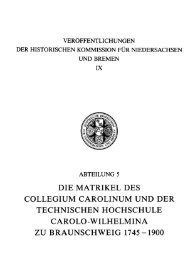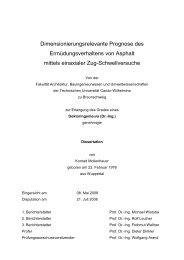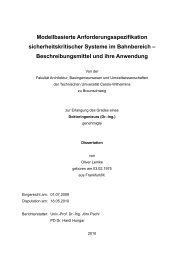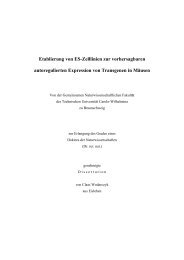- Page 1 and 2: National Institute on Drug Abuse RE
- Page 3 and 4: ACKNOWLEDGMENT This monograph is ba
- Page 5 and 6: As a psychopharmacologist, Sid was
- Page 7 and 8: I respectfully conclude this tribut
- Page 9 and 10: It is hoped that this monograph wil
- Page 11 and 12: Contents (Continued) Section III So
- Page 14 and 15: Introduction to Inhalant Abuse Char
- Page 16 and 17: chemical properties. Sometimes the
- Page 20 and 21: exemplified by cases of asthma inha
- Page 22 and 23: Research Monograph 15. Rockville, M
- Page 24: Author Charles W. Sharp, Ph.D. Nati
- Page 27 and 28: The term “inhalants,” however,
- Page 29 and 30: Figure 1. Lifetime prevalance for h
- Page 31 and 32: this substance will be widespread b
- Page 33 and 34: Another pattern that commonly occur
- Page 35 and 36: since a great deal of research has
- Page 37 and 38: differences tend to be largest at t
- Page 39 and 40: gradually increasing, although ther
- Page 41 and 42: percent, 12.5 percent, 9.8 percent
- Page 43 and 44: use three times higher than those f
- Page 45 and 46: street youths, and the lifetime and
- Page 47 and 48: and it may well be that the researc
- Page 49 and 50: More data are needed on the economi
- Page 51 and 52: Carlini-Cotrim, B., and Carlini, E.
- Page 53 and 54: (ADM)87-1527. Rockville, MD: Nation
- Page 55 and 56: Acknowledgment Preparation of this
- Page 57 and 58: use. When we designed the Texas Sch
- Page 59 and 60: Poppers, Locker Room, Rush, Medusa,
- Page 61 and 62: way as “inhalants” or “volati
- Page 64 and 65: Epidemiology of Inhalant Abuse: A C
- Page 66 and 67: ignored by those doing the research
- Page 68 and 69:
among those getting drug abuse trea
- Page 70:
abuse, remains to be studied. The r
- Page 73 and 74:
from families with alcohol and/or d
- Page 75 and 76:
The inhalant users themselves often
- Page 77 and 78:
with only 3 percent of a control gr
- Page 79 and 80:
thought disorders. Further, if the
- Page 81 and 82:
(Gilbert 1983; Guitierrez et al. 19
- Page 83 and 84:
those most susceptible to inhalant
- Page 85 and 86:
It also suggests that the value of
- Page 87 and 88:
Basic Epidemiology Once a problem h
- Page 89 and 90:
forms of data. The theoretical cons
- Page 91 and 92:
cause it is more available, because
- Page 93 and 94:
An example of trying to transfer a
- Page 95 and 96:
Figure 2. Model for an agenda for p
- Page 97 and 98:
niches? Are they scapegoats, the bu
- Page 99 and 100:
tempting. For example, initiation a
- Page 101 and 102:
Inhalant users consistently show hi
- Page 103 and 104:
The underlying theme of psychosocia
- Page 105 and 106:
Beauvais, F.; Oetting, E.R.; and Ed
- Page 107 and 108:
Jacobs, A.M., and Ghodse, A.H. Deli
- Page 109 and 110:
Reed, B.J.F., and May, P.A. Inhalan
- Page 112 and 113:
Ethnomethodology, Psychosocial Meas
- Page 114 and 115:
all too well that each individual r
- Page 116 and 117:
questionnaire items we can conceiva
- Page 118 and 119:
ethnic minority substance abuse res
- Page 120 and 121:
conceived, ethnic identity consists
- Page 122 and 123:
Forbes, J.D. The manipulation of ra
- Page 124 and 125:
Comments on Psychosocial Characteri
- Page 126 and 127:
With regard to resources, it seems
- Page 128:
strategies used to reduce HIV infec
- Page 131 and 132:
turning to drowsiness, disinhibitio
- Page 133 and 134:
fact, comes from documented cases o
- Page 135 and 136:
some solvents may create additional
- Page 137 and 138:
accident (Cherry et al. 1982). Alth
- Page 139 and 140:
et al. 1988; Husman and Karli 1980,
- Page 141 and 142:
neuropathy seen in the most severel
- Page 143 and 144:
into complete remission with prolon
- Page 145 and 146:
abnormal in 3 of 11 individuals, an
- Page 147 and 148:
ilaterally over the ensuing 2 to 3
- Page 149 and 150:
Methylene chloride (dichloromethane
- Page 151 and 152:
are associated with hypoxic encepha
- Page 153 and 154:
elate to the psychological dependen
- Page 155 and 156:
al. 1988). In addition, an intersti
- Page 157 and 158:
However, a recent report may have i
- Page 159 and 160:
This methemoglobinemia is the major
- Page 161 and 162:
Antti-Poika, M.; Juntunen, J.; Mati
- Page 163 and 164:
Brown, B.R., and Gandolfi, A.J. Adv
- Page 165 and 166:
Ehyai, A., and Freemon, F.R. Progre
- Page 167 and 168:
Gamberale, F., and Hultengren, M. M
- Page 169 and 170:
Haverkos, H.W, Pinsky, P.F.; Drotma
- Page 171 and 172:
Keogh, A.M.; Ibels, L.S.; Allen, D.
- Page 173 and 174:
Lindstrom, K., and Wickstrom, G. Ps
- Page 175 and 176:
Mirvish, S.S., and Haverkos, H.W. B
- Page 177 and 178:
Plaa, G.L. Experimental evaluation
- Page 179 and 180:
Sagawa, K. Transverse lesion of the
- Page 181 and 182:
Spencer, P.S., and Schaumburg, H.H.
- Page 183 and 184:
Valpey, R.; Sumi, S.M.; Copass, M.K
- Page 186 and 187:
Clinical/Biophysiologic Aspects of
- Page 188 and 189:
where (Cavanagh 1983). The gold sta
- Page 190 and 191:
chologic morbidity and the effects
- Page 192 and 193:
Fornazzari, L.; Wilkinson, D.A.; Ka
- Page 194 and 195:
Death Among Inhalant Abusers James
- Page 196 and 197:
The inhalants identified in all cas
- Page 198 and 199:
Deaths Resulting From Inhalant Abus
- Page 200 and 201:
This analysis provides a new perspe
- Page 202 and 203:
The role of other factors, such as
- Page 204:
Marshall, B.E., and Wollman, H. Gen
- Page 207 and 208:
experimented with inhalant abuse (J
- Page 209 and 210:
typewriter correction fluids freque
- Page 211 and 212:
Interviews with friends and school
- Page 213 and 214:
Litovitz, T.L.; Schmitz, B.F.; and
- Page 216 and 217:
Treatment of Volatile Solvent Abuse
- Page 218 and 219:
have experimented with them for a b
- Page 220 and 221:
the cluster with a more constructiv
- Page 222 and 223:
is more likely that family members
- Page 224 and 225:
1. Extensive involvement of the fam
- Page 226:
Carroll, L.T., eds. Voluntary Inhal
- Page 229 and 230:
and its role in the general psychos
- Page 231 and 232:
consistent with the high rate of le
- Page 233 and 234:
The major reasons youths gave for u
- Page 235 and 236:
fourth had experienced suicidal tho
- Page 237 and 238:
along with education about the grow
- Page 239 and 240:
Oetting, E.R., and Beauvais, F. Pee
- Page 242 and 243:
Treatment and Prevention Research I
- Page 244 and 245:
make a controlled evaluation by ran
- Page 246 and 247:
Animal Research on Solvent Abuse Go
- Page 248 and 249:
with prolonged exposure. However, b
- Page 250 and 251:
Drug Self-Administration The princi
- Page 252 and 253:
had been suppressed by punishment (
- Page 254 and 255:
cols were still geared to the indus
- Page 256 and 257:
with the exception of n-hexane (Pry
- Page 258 and 259:
Table 1. Signs and symptoms most fr
- Page 260 and 261:
Figure 1. Centroids of groups of ra
- Page 262 and 263:
Other solvents were examined for th
- Page 264 and 265:
dams. Clearly the issue of in utero
- Page 266 and 267:
Howd, R.A.; Bingham, L.R.; Steeger,
- Page 268 and 269:
Pryor, G.T.; Dickinson, J.; Howd, R
- Page 270 and 271:
Repko, J.D. Neurotoxicity of methyl
- Page 272 and 273:
Basic Science Solvent Abuse Researc
- Page 274 and 275:
Levels of Analysis Drug abuse is a
- Page 276 and 277:
Animal Research as a Guide to Regul
- Page 278 and 279:
against its abuse liability and ris
- Page 280 and 281:
versa. In this respect, it seems th
- Page 282 and 283:
unfamiliar environments, and in ind
- Page 284 and 285:
imply a moral or personality defect
- Page 286 and 287:
Wood, R.W. Reinforcing properties o
- Page 288 and 289:
An Industrial/Economic Perspective
- Page 290 and 291:
fatal.” The industry label was ap
- Page 292 and 293:
that time and money had been spent
- Page 294 and 295:
What are the costs to the Nation of
- Page 296 and 297:
Flowers, H.C.; Hand, R.C.; and Hora
- Page 298:
Author Robert P. Giovacchini, Ph.D.
- Page 301 and 302:
Table 1. Chlorofluorocarbons—prop
- Page 303 and 304:
Table 3. CFCs and alternatives Curr
- Page 305 and 306:
Table 6. Toxicological summary of c
- Page 307 and 308:
Table 9. PAFTT proposed toxicity te
- Page 309 and 310:
Table 12. Present toxicity testing
- Page 311 and 312:
Table 15. Comparative toxicity of C
- Page 314 and 315:
Recommendations The focus of the co
- Page 316 and 317:
tions on inhalants. At a minimum, v
- Page 318 and 319:
and other disease factors affecting
- Page 320 and 321:
26. Studies are needed to examine t
- Page 322 and 323:
methods for good work adjustment ha
- Page 324 and 325:
While limited supplies last, single
- Page 326 and 327:
80 NEEDLE SHARING AMONG INTRAVENOUS
- Page 328 and 329:
98 THE COLLECTION AND INTERPRETATIO
- Page 330 and 331:
NTIS PB #92-146216 Paperback $43.00
- Page 332:
National Institute on Drug Abuse NI


